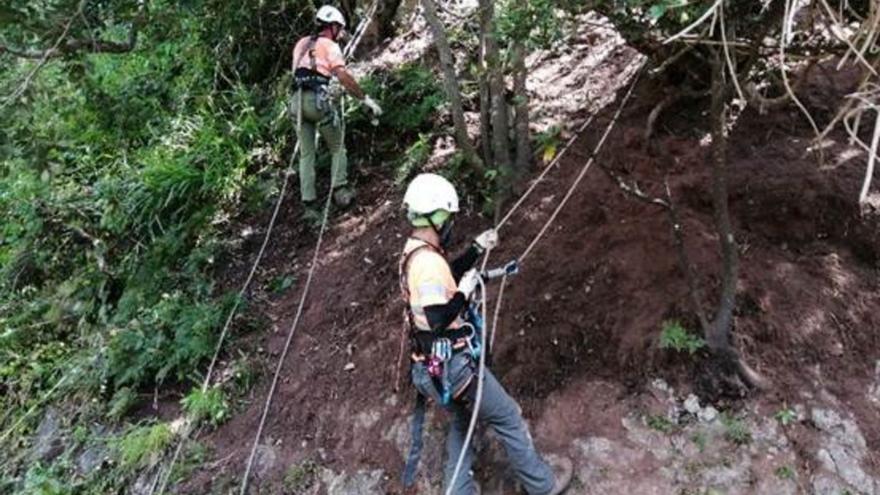
Efforts are underway to combat Ulex Europaeus, the scientific designation for the plant commonly referred to as gorse or Galician toxo, which is also known locally as hawthorn. According to the noincineraciónTenerife portal, this invasive species has developed into a significant issue, as its extensive spread and the uncontrolled growth of its populations, particularly in the inland areas of the northern region, pose a threat to local flora and fauna, as well as several protected natural environments. The risk posed by its presence, as it serves as a potent fuel for wildfires, has escalated with the devastating forest fires experienced in recent years, including the incidents of 2022 that originated in The Campeches—within the higher elevations of Los Realejos and San Juan de la Rambla—and the large-scale fire during the summer of 2023.
This non-native plant was brought to the Island in the 19th century to ensure livestock sustenance. Its proliferation paralleled the reforestation efforts of the 1950s and 60s involving the so-called radiata or Californian pine—an imported species far less resilient to fire than the native Canarian varieties—which is currently undergoing replacement with monteverde.
Gorse is a shrub, the most emblematic of Galicia, belonging to the legume family, capable of reaching a height of three metres. It is thorny, highly branched, particularly at the younger shoots, which are characterised by long and prominent hairs, and displays a general dark green hue. Another notable feature is the presence of elongated spines, measuring up to four centimetres, situated at the tips of the twigs.
This may be surprising for many Galicians, who are used to seeing a plant that has been extensively utilised since ancient times, but outside its natural range, gorse is a potentially highly detrimental shrub. This is why it has been included in the Spanish Catalogue of Invasive Exotic Species, governed by Royal Decree 630/2013, dated August 2. It is listed among the 100 most harmful species globally.
Blanca Perez, Natural Environment Advisor of the Cabildo, clarifies: “We are diligently working to manage invasive flora across all the protected areas of the Island.” She regards these efforts as “crucial steps in conserving our biodiversity.” Perez warns that “eradicating these species is a slow and arduous process, yet it facilitates the gradual recovery of habitats with significant environmental value that have been adversely affected by introduced plants.” She stresses the importance of collective responsibility in preventing their harmful spread within endemic and native ecosystems. A commission from Gesplan, operating with a budget of 1.1 million euros, is advancing control measures in the protected zones of Teno and Anaga, as well as in both the northern and southern regions.
The Cabildo of Tenerife has devised an evaluation and eradication plan for gorse that dates back to November 2016. Unfortunately, the concerns raised in that document have now become a troubling reality.
The Data: Anaga Rural Park
12 tonnes of invasive species eradicated
Natural Environment of the Cabildo of Tenerife successfully removed twelve tonnes of invasive exotic species from the Anaga Rural Park last year. The work conducted this year, overseen by Gesplan, covered an area of 505 hectares. Of this, 64.5% of the efforts were dedicated to the extraction of the so-called red geranium (Pelargonium inquinans) and 9.7% to Indian battilla (Ipomoea indica). Efforts also involved the eradication of aloé, crassula, senecio, and pinillo. Over the past five years, the Cabildo, through the public entity Gesplan, has undertaken more than a thousand interventions across various locales within the park, particularly in the areas of Afur, Taganana, Bejía, and in specific locations such as Tierras Altas, Margalua, and Benijo—each influencing Taganana—and El Cresal, deep in the San Andrés highlands, among other isolated locations. In total, activities have spanned an area of 1,500 hectares. Notably, 89% of the actions focused on eliminating the cat’s tail (Pennisetum setaceum), from which 44.4 tonnes have been extracted. Indeed, the cat’s tail has received the most attention, followed by the crassula (Crassula multicava), accounting for 3.27% of the total effort. The removal of thousand loves (Centranthus ruber) constituted 2.11%, and prickly pear (Opuntia maxima) made up 1.24% of the square metres cleared of invasive species.















